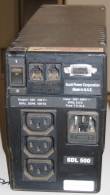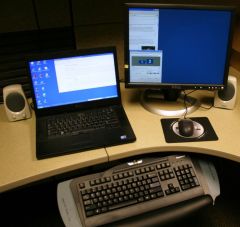






4.5. Peripheral and I/O Hardware
Things you must have (or know)
After new & future I/O, this may be a bit of a let down. Frankly, I just didn't know where to fit this material in. Nevertheless, some of it is truly necessary and some just highly desirable.
Ergonomics [src]
Ergonomics is employed to fulfill the two goals of health and productivity. It is relevant in the design of such things as safe furniture and easy-to-use interfaces to machines. Proper ergonomic design is necessary to prevent repetitive strain injuries, which can develop over time and can lead to long-term disability.
With laptops and hand-helds, we have adopted more "relaxed" postures than was typical 20 years ago. These may have some value in allowing more variation. The worst case seems to be working in essentially the same (bad) position for long periods of time, causing physical strain.
So, what do you need for long term use of a computer? A good chair and a computer desk with a keyboard tray. Don't forget glare! A window behind the screen, or behind you, needs a good curtain. The image at right applies equally to desktop units and laptops (see docking stations below).

Computer workstation ergonomics
public domain image
The latest fad seems to be "standing desks" and desks that convert from sitting to standing. This at least allows you to continue to work without always sitting, but you might want to look at 7 Reasons Why You DONíT Want a Standing Workstation before you invest in one of these.
 #144 Ergonomics 101
#144 Ergonomics 101
Surge Protector
Surge protectors protect against lightening strikes, right? Well, yes, but often when power is restored after an outage it is accompanied by a spike, i.e., a brief period of too much voltage. The more sensitive your electronics, the more you have to worry about this.
Surge protectors are designed to detect sudden high voltage peaks and to prevent them from being passed on to the equipment connected through it. This includes power, but may also include other wiring, such as telephone and networking. (Lightening can strike there too.) Device ratings include:
- Clamping voltage – what the device will let through; 330 volts is common (normal voltage in the US is 120V). Lower is better.
- Joules rating – How much energy the protector can absorb. 1000 joules and 40,000 amperes is a good minimum, although this can be misleading because most devices also divert excess energy to ground, rather than absorb it. Higher is better.
- Response time – measured in nanoseconds. Lower is better.
I know of no standard that says so, but if the surge protector's light is dim or flickering, this generally means that it has taken a surge that damaged it. It needs to be replaced!

Surge protector with USB (charging) ports
public domain image

A power strip is not a surge protector. It's an extension cord with a switch.
Photo by Dante Alighieri, licensed under the Creative Commons Attribution-Share Alike 3.0 Unported license
UPS [src]
An uninterruptible power supply (UPS) is an electrical apparatus that provides emergency power when the input power source, typically the utility mains, fails. The primary role of any UPS is to provide short-term power when the input power source fails. However, most UPS units are also capable in varying degrees of correcting common utility power problems:
- Power failure: defined as a total loss of input voltage.
- Surge: defined as a momentary or sustained increase in the main voltage.
- Sag: defined as a momentary or sustained reduction in input voltage.
- Spikes, defined as a brief high voltage excursion.
- Noise, defined as a high frequency transient or oscillation, usually injected into the line by nearby equipment.
- Frequency instability: defined as temporary changes in the main's frequency.
- Harmonic distortion: defined as a departure from the ideal sinusoidal waveform expected on the line.


UPS unit
Images by Amakuru. Licensed under the Creative Commons Attribution-Share Alike 3.0 Unported license.
 #124 Surge Protection & UPS
#124 Surge Protection & UPS
Note that most UPS units act a surge protector. Great for desktop PCs! UPSs (big ones) are used for mainframes, important servers, etc. Your laptop battery will take over when power fails, but offers no surge protection.
Docking Station
Docking stations may be purchased from your laptop manufacturer or a compatible unit (see if they recommend one) can be purchased independently. There is no standard and docking stations provide different functionality, so you should do a little research before buying. For some, the laptop is directly connected, while for others, it is a mini-tower that attaches by USB.
The advantages provided by a docking station tend to be a full sized monitor, standard keyboard, and mouse. Other peripherals may become available on the desktop also, such as external speakers, disk drives, and optical storage devices. It may also provide power for charging while docked, although you may have to use your normal charger. It is sometimes possible to "extend" your laptop screen to a desktop monitor, or to directly attach two monitors, providing dual monitors while docked.

Laptop "docked". Screen shows MS Windows Display Properties setting screen to "dual" mode. FireFox spans the screens.
By Paul Mullins: photo

Docking station (side ports)
By Paul Mullins: photo

Docking station rear ports
By Paul Mullins: photo

Docking station with desktop peripherals attached.
By Paul Mullins: photo
Laptop Battery

Most laptop batteries today are Lithium Ion batteries, as in many hand-held devices. Your laptop has a battery management system that tries to keep things in an optimal state.
Li-ion batteries will normally degrade over time (3-5 years), so don't purchase a replacement battery when you buy the system. Heat will cause the battery to degrade more quickly. This includes operating temperature and ambient. Don't leave the battery in a car, and don't place your laptop on blankets or carpet (put a large book or stand under it). If you do have a spare battery, store it in the refrigerator (in a sealed container).
Li-ion batteries like to stay charged. Most hand-held devices recommend "topping off" the charge regularly. Each battery also has a maximum number of charge-discharge cycles. You get 300-500 full discharge cycles, but around 4700 cycles with a 10% depth of discharge.
Should you leave your laptop plugged in, after it is fully charged? Yes! The slightly higher voltage while in a charging state, assuming your battery management system doesn't prevent that, also causes some degradation. However, the only option is to unplug, use the battery, and then recharge. If you use your laptop for long periods of time, this will quickly use up your recharge cycles. (Just one full cycle, once per day will use 365 cycles in a year!)
And, no! (Sorry.) Leaving the battery plugged in may result in some degradation because of higher voltage, over heating (especially if you are not assuring proper airflow), and wasted energy. That, combined with the slim possibility of a fire, argues for removing the battery after it is charged — this sidebar is recommended. Kind of the best of both worlds. On the other hand, your laptop will still be plugged in and, without battery, subject to power failures. (If you have reason to suspect a power outage, like stormy weather, put the battery back in.)
 Extending battery life.
Extending battery life.BatteryUniversity.com appears to be owned by Cadex Electronics Inc.







